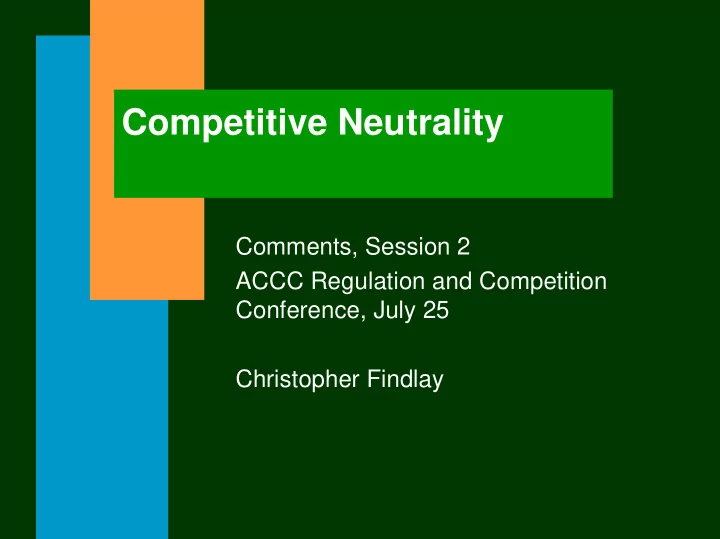

Competitive Neutrality Comments, Session 2 ACCC Regulation and Competition Conference, July 25 Christopher Findlay
Overview ■ Illustrate some of the key points by reference to the water sector ■ See if any special complications arise ■ Find 4 issues
The structure of the problem ■ The rat tail applies – water ✜ alternative supplies of water after treatment – rivers, dams, recycling, desalination – wastewater services ✜ recycling ✜ catching storm water – competition in grey water?
Transition ■ Potential interest among competitor suppliers in arranging access to bottleneck infrastructure – unlikely to build long distance haulage or short connections ■ So far access demands not common – But transition is coming
Routes around the bottleneck? ■ In some services, alternative technologies can be used to bypass the bottleneck – eg mobile, satellite in telco – alternative forms of energy ■ Fewer or no options in water? – On site technologies?
Issue #1: revenue targets ■ Governments collect tax revenue through utility dividends – entrants given access could capture the $$$ – policy responses ✜ endorse ECPR (section III) ✜ a process of negotiation (p. 32 onwards) – role of arbitrator important – but what about a sales tax equivalent? (p. 19)
Issue #2: funding cross subsidies ■ Postage stamp pricing – cross subsidies between city and rural users ✜ entrants would be expected to contribute (p. 20 onwards) – to not do so violates neutrality conditions – but what about some unbundling? ✜ Variations in funding mechanisms and service qualities
Issue #3: dynamic efficiency ■ Options exist for bulk water supply or waste water processing – expect a variety to survive – neutrality requires no bias in adoption of new technologies, either inhibit (access prices too high) or promote (access prices too low) [p. 17] ✜ incentives in the opposite directions in investment in the bottleneck infrastructure
Issue #4: choice of optimal regulation ■ Minimise costs of administration and errors ■ Administrative costs are high – including gaming costs ■ Increase with the extent of and degree of discretion in regulation
Issue #4 cont. ■ Errors – Type I: incorrectly condemn competitive behaviour [regulatory failure] – Type II: exonerate anti-competitive conduct [market failure]
Issue #4: ■ Lighter regulation – risk of regulatory failure high, cost of market failure low ■ Heavier hand – risk of regulatory failure low, costs of market failure high ✜ depending on administrative costs
Issue #4: ■ Conventional wisdom is that a heavier hand is right for infrastructure – paper shows the chance of regulatory failure! ✜ And high level of admin costs – How bad is the market failure? ✜ degree varies between sectors depending on routes around the bottleneck ✜ no one solution?
Review ■ Value of – a broader tax base for revenue targets – unbundling service obligations – dynamic efficiency matters – questioning the role of universal application of a heavy hand in infrastructure regulation
Recommend
More recommend